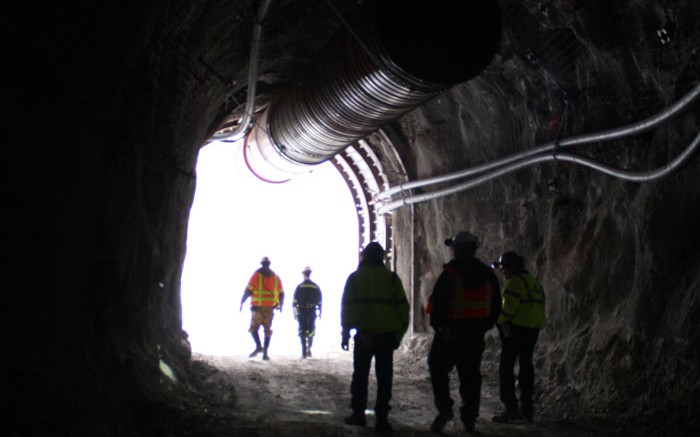Atna Resources (TSX: ATN; US-OTC: ATNAF) is setting itself up for a comeback after finishing last year with a huge net loss, significant impairment charges, a suspended mine and a battered share price.
The junior gold producer, based in Golden, Colo., reported a 2013 net loss of US$49.6 million, or negative US32¢ per share, compared to a US$6.9-million profit, or US5¢ a share, in 2012.
The loss resulted from US$33.1 million in non-cash impairments, including US$30.7 million for the secondary access development at its suspended Pinson underground gold mine in Nevada, and US$2.4 million for its other non-core assets.
Atna put Pinson on care and maintenance last June due to a host of factors: the declining gold price; slower than expected development at Pinson; lower production at its flagship Briggs gold mine in California; and a depleted treasury.
“This was a necessary action, but one that significantly impacted our share price,” James Hesketh, Atna’s president and CEO, said on a conference call discussing the 2013 financials.
Its stock went from 42.5¢ on May 29, the day before Atna announced the suspension, to 11¢ at the end of June. The company also closed 2013 at 11¢, 90% below where it started trading that year.
The junior is reviewing Pinson’s mine plan and mining methods, noting what role the gold price would play when development resumes.
“We need some more strength and stability in the gold-price environment,” says Valerie Kimball, Atna’s manager of investor relations. “When we started that mine at the end of 2012 . . . we were looking at much higher prices, so we definitely need a turnaround in the gold market.”
Hesketh notes while most of last year’s impairment charges were for the Pinson mine, the company still views Pinson as a high-quality project. “I would like to emphasize that this impairment does not impact our view as to the value or potential of the overall resource at Pinson . . . it is more a reflection of the need to re-evaluate our existing development plans and improve the project based on our development experience to date.”
On that end, the company intends to swap the costly underhand cut-and-fill mining method at Pinson with the cheaper bulk-mining method, as the mine’s ground conditions are better than envisioned, resulting in less ore dilution.
“We found we were able to upgrade mined ore by screening out both internal and external rock dilution on the surface at quite a low cost. As a result we have [begun] upgrading the Pinson resource model based on the experience gained in development,” Hesketh notes. A new mine plan will be developed around the new resource model using bulk-mining methods where possible, and a screening plant will be added for waste-rock removal.
Atna is working on a prefeasibility study for the Mag open-pit project, adjacent to the Pinson underground mine, which could also improve Pinson’s economics.
“This study does not assume any synergies with the underground project, but in reality an open-pit heap-leach operation will provide significant cost-reduction synergies for the underground project through overhead sharing and the ability to process underground oxide ores in the heap leach versus shipping to expensive third-party processing plants,” Hesketh comments.
At Briggs, Atna will rein in costs and boost productivity. The company is also looking at ways to extend Briggs’ mine life by developing a satellite pit and building a power line to the mine.
“Line power to replace the diesel generators would require roughly 8 miles [12.8 km] of power-line construction. This addition could reduce site cash costs by as much as 15%, which may be translated into additional reserve life at Briggs,” Hesketh says. Atna is reviewing the cost benefits of this proposal.
Briggs’ current reserves could take it to the end of 2017, Hesketh says, adding that afterwards the mine would have another year and a half in residual gold recovery.
Last year Atna recovered 32,800 oz. gold from Briggs and 6,800 oz. from Pinson. Total gold sales from both mines were 36,252 oz. at an average sales price of US$1,412 per oz., compared to 36,454 oz. sold at US$1,667 per oz. in 2012.
The all-in sustaining costs at Briggs rose 9% to US$1,249 per oz. in 2013, as the company focused on pre-stripping new production areas in the first five months of the year. As a result, the average waste-to-ore strip ratio more than doubled to 4.4 tons (3.9 tonnes) in 2013.
Operating cash flows were US$8.3 million — a US$$5.3-million decrease from 2012 — principally because revenues declined by 25% to US$45 million in 2013, says Rodney Gloss, Atna’s chief financial officer. He attributes the drop in revenue to lower gold prices and less ounces produced and sold.
Given the tough operating year, Atna spent the second half of 2013 restructuring its operations as well as its debt. Earlier this year it signed a US$22-million, two-year debt facility with Waterton Precious Metals Fund to repay the $18.1 million it owed Sprott Resource Lending.
“With the company now on a stronger financial footing, we are looking towards the future,” Hesketh says.
“Our overall goal is to improve operating cash-flow generation at our Briggs mine while adding value to our portfolio of core development assets. We believe that these activities are preparing Atna for growth in this new gold cycle and will add to shareholder value.”
The junior is guiding gold production of 40,000 to 45,000 oz. from Briggs this year.
Atna shares closed March 19 flat at 16¢, after losing 18% a day earlier on the financial results.
It exited last year with US$800,000 in cash and equivalents.


Be the first to comment on "Atna finishes 2013 in the red, but remains optimistic"